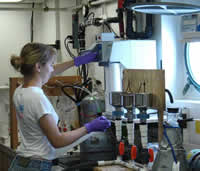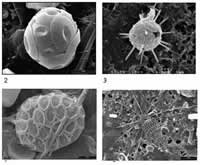


|
The Project Part 3:
Also See: Part 1: Part 2:
|
August 31, 2005
We should arrive at our destination by 1900 Pacific Time, or 7 pm, which is earlier than we had planned. Weather has been very good. Today is overcast, but not much wind and gentle seas, so we have traveled smoothly and quickly. Fred, the chief scientist, is busy reconfiguring the schedule to plan what work we will all be doing tonight. Fred and his group of scientists are studying coccolithophores. There are many different species of these plants. They live in most of the oceans of the world. They don't really like the equator (too hot) or the poles (too cold), but they exist just about everywhere else. They seem to avoid coastlines. They grow at different levels, but not too deep because of the lack of light. To learn more about these little plants, click on the Project link. I've been interviewing scientists today to find out about their work. Brian is interested in finding out more about how these plants deal with carbon dioxide. We know they use it in created calcium carbonate plates, called cocoliths, around themselves, but we don't know why. Scientists can tell the different species by the shape of the plates they form. Here are a couple pictures of plates taken from BALESTRA, B., ZIVERI P., MONECHI, S., TROELSTRA, S. (2004). Brian feels that if we can learn more about how these plants use carbon dioxide, we can get a better picture about our future atmosphere. Try looking up information about global warming. What are greenhouse gases? Why do we care about the levels of carbon dioxide in our atmosphere? We are the last part of a three cruise venture this summer to learn more about coccolithophores. The first two, which you can link to on this site, were located in the Gulf of California. This cruise is headed out to a much different area to gather information of how these plants live and work in a different environment. We have seen some wildlife. A few people saw a whale blow, but I didn't get on deck fast enough to see it. I have, however, seen a few porpoise, which are closely related to the dolphin. Do a search on google or yahoo and look up pictures of a porpoise and a dolphin. See if you can tell them apart. What makes them different? What makes them similar? The ones we saw here travel in pods, or groups, as is usual. They are black with a white spot on each side, so they look like a miniature orca, also known as a killer whale. They are only about five feet long. They come up to the ship to play, and they seem very happy to greet us. They leap about in the bow waves. I am amazed at how fast they swim. But, much like children, they soon get distracted or tired of this game, and they move on to something new. I am always sad to see them go. Another thing I am discovering is the world of work out here on the ocean. Obviously there are the scientists and people helping with the research. There is also a ship crew to run the ship. Today I talked with Doug Capps, the head cook, and Aaron, his assistant. Doug has been working on the Wecoma for 11 years. He enjoys the adventure of going so many different places. Doug says that with a little training and experience, anyone interested could work on a ship. Aaron has been here about two years. He believes there are a lot of opportunities for work at sea. Maybe you would like to get a job like this. Anyone who works in the maritime industry must get a Merchant Mariners Document through the Coast Guard. Math Questions: A common dolphin can swim 70 miles per hour. How far could it swim in three hours? 12 hours? What would the distances be in leagues (one league = three nautical miles)? A bottlenose dolphin can jump up to 16 feet out of the water. The male Olympic record for the high jump is 7 feet 9.75 inches. The female record is 6 feet 8 inches. How much higher can the dolphin jump than the male? the female? Ocean Trivia: The largest bony fish is the bluefin tuna. (Sharks are larger fish, but they have cartilage instead of bone.) An adult bluefin tuna may weigh up to 1500 pounds. They can swim up to 55 miles per hour. Since they are so greatly desired in Japan for sushi, one fish could sell for as much as $20,000 at U.S. docks.
|



